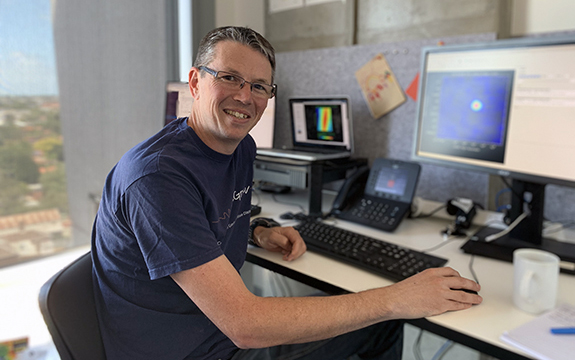Swinburne astronomer awarded Pawsey Medal for scientific excellence

In Summary
- Associate Professor Adam Deller has been awarded the Pawsey Medal by the Australian Academy of Science
- The Pawsey Medal recognises outstanding research in physics by early-mid career scientists.
- Associate Professor Deller uses radio imaging to study neutron stars and black holes
- He has developed new instrumentation that has been adopted by major astronomy facilities worldwide
Swinburne’s Associate Professor Adam Deller has been awarded the prestigious Pawsey Medal by the Australian Academy of Science.
The Pawsey Medal recognises outstanding research in physics by early-mid career scientists.
Associate Professor Deller is an Australian Research Council Future Fellow and an Associate Investigator of the Centre of Excellence for Gravitational Wave Research, known as OzGrav, which is headquartered at Swinburne.
He uses radio imaging to study neutron stars and black holes, the most compact objects in the Universe.
To do so, he has developed new instrumentation capable of jointly processing signals received by radio antennas spread across the Earth and even on orbiting satellites. This instrumentation has been adopted by major astronomy facilities worldwide.
Associate Professor Deller’s use of these facilities had led to breakthroughs in astronomy including directly imaging the explosive aftermath of a merger of two neutron stars in a galaxy 125 million light years away. This ultra-high zoom radio movie determined the orientation of the stars as they collided, and fed new insights into the analysis of the burst of gravitational waves emitted when they coalesced.
Closer to home, he has pinpointed the location of neutron stars within the Milky Way galaxy with unprecedented precision, using radio observations so precise they could discern motion no greater than the width of a human hair at a distance of 2,000 kilometres.
Associate Professor Deller is passionate about astronomy.
“I love the challenge of radio astronomy in particular – it has a tight relationship with engineering which is something that I studied as an undergraduate,” he says.
“But the main thing that draws me in is the search for discovery. It doesn’t often happen all at once in a classic lightbulb moment, but when you get that breakthrough, or see that first image, and you know that at that instant you’re the only person in the world that has that information – it’s incredibly exciting and you can’t wait to get out there and share it with everyone else.”
“Science is a question multiplier,” he adds. “Every new answer you find tends to lead to not one, not two, but usually five more questions. It’s very rare that we get to the end of a study and everything is wrapped up in a neat little bow and we think ‘ah, now we understand’. But that’s also the beauty of it. There’s always more to understand about the Universe.”
Distinguished Professor at Swinburne’s Centre for Astrophysics and Supercomputing and Fellow of the Australian Academy of Science, Professor Karl Glazebrook, says Associate Professor Deller is an amazing astronomer and computer scientist.
“We are especially proud of him as he studied here as a Swinburne undergraduate and also for his PhD, and he is the first of those students to return here as a permanent member of the astronomy staff.
“Adam’s research and work on interferometry software has had an enormous impact on the worldwide community and the Pawsey Medal is very well deserved,” Professor Glazebrook adds.
Associate Professor Deller says he is honoured to be awarded the Pawsey Medal by the Australian Academy of Science and acknowledges his fellow researchers.
“Science is always a team effort, and all of these results have been dependent on my collaborators, my mentors, and my students, and so this award is as much a recognition of their work as it is of mine,” he says.

